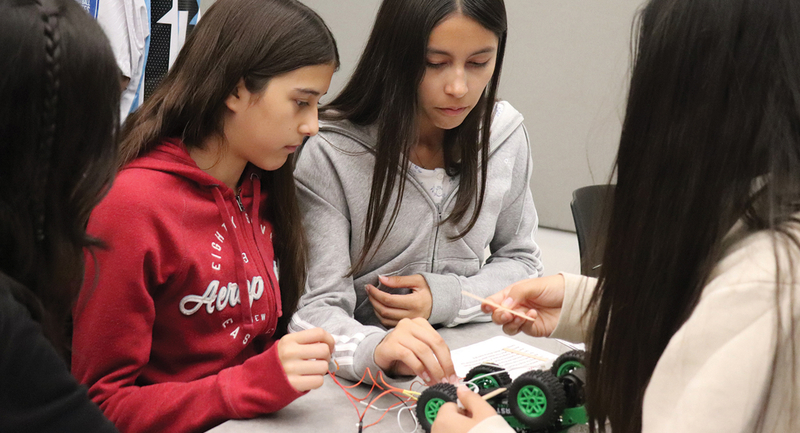At her district's newcomer center, English as a Second Language teacher Barbara Gottschalk would engage parents in a visual exercise: compare a math textbook from 20 years ago to the one in use today. The former, a familiar reproduction of the kind of math newcomers most likely experienced in their home countries, was defined by rows of computation. In the current textbook, however, words abound.
"You could tell just by looking at the two that even a student with a strong background in math will need some language support in a mainstream math class," says Gottschalk, who teaches at Susick Elementary in Troy, Michigan. A student with interrupted or limited schooling, she adds, will need even more language support.
With the Common Core State Standards and, especially, the skills identified in the Standards for Mathematical Practice, mathematics has increasingly emphasized conceptual understanding and reasoning, in addition to procedural know-how. "Language is the entirety of the mathematics classroom," says Megan Rowe, a math teacher at Borah High School in a linguistically diverse district outside Boise, Idaho. "From the language I use when I'm teaching to the language students use when they're reasoning among their peers—I don't know how you could ever teach mathematics now without focusing on language."
Double-Edged Disadvantage
Yet there's evidence across the education sector that many still assume English language learners (ELLs) don't need language support in math, and that belief can create a double-edged disadvantage for such students. ELLs placed in mainstream math courses with little to no language support are more likely to flounder under increased linguistic demands. However, when ELLs are tracked into remedial classes—and researcher Eduardo Mosqueda reports that this is a common and pernicious trend—it severely reduces the likelihood that they will eventually take advanced math courses.
"Once you start looking at math through the lens of language, you see linguistic demand everywhere," says San Diego State University professor Bill Zahner, a former high school math teacher. Without awareness and planning to support ELLs with that linguistic load, language will continue to be a gatekeeper to the advanced courses that lead to in-demand, well-paying careers in STEM fields. For Zahner and others, it's a question of equity: "How do we meet the needs of linguistically diverse students in math?"
Build a Baseline
When working with ELLs, it can be easy to mistake lags in language for gaps in math learning. "Just because they don't have the words doesn't mean they don't know how to do it," says Gottschalk. That's why middle school ESL teacher Beth Morrow's first rule of supporting ELLs in the math classroom is assess, don't assume. Establishing a baseline of where students are in terms of math knowledge and language proficiency helps teachers tailor the content and English supports ELLs receive.
Gottschalk uses a simple, language-free, calculation-based assessment to screen students' content knowledge. But even with pared-down assessments, cultural differences in math notation can make screening students challenging.
"Although there are some common rules that all mathematicians and scientists use, worldwide, they manifest themselves differently depending on the culture," says Cassie Eatmon, math chair at Herndon Middle School in Virginia. For example, long division is set up differently in the United States than in South American countries, and Arabic notation is written right to left. "Subtracting in Arabic looks wrong to us, but it's actually just flipped," explains Gottschalk.
Incorporate Semantic Supports
For newcomers, Eatmon recommends gradually increasing language demands. "Phrase questions that require them to produce a minimal amount of English at the beginning," she recommends. Choice questions (that require a yes/no, true/false, and ways for them to communicate nonverbally via a word card or hand signals) are a good place to start. As newcomers develop confidence with language skills, stretch expectations for discourse.
"Newcomers need special handling for a while," says Rita MacDonald, researcher at WIDA and the Wisconsin Center for Education Research (WCER). "However, students are newcomers for the short term; they are language learners for a long time."
For the long haul, ELLs will need different levels of support to engage in increasingly language-rich mathematics. Visual representations of concepts, word walls, defining word parts (prefix, root, suffix), sentence frames, and note-taking practice—common tools in language arts learning—can be adapted in order to make math-centered conversations more accessible to ELLs. For example, Eatmon recommends adapting the traditional think-pair-share processing strategy to think-write-pair-share so that students will have a script of their thoughts to refer to. "That reduces the burden on ELLs to think and talk [in a new language] at the same time," she explains.
Language in Use
Researchers at WCER have developed six specific moves teachers can make to strengthen all students' reasoning skills in mathematics, especially ELLs (), as well as seven tactics students can apply when working with ideas in math (). These strategies develop language through doing mathematics, what MacDonald calls a "language in use" approach. "It used to be a common belief that you had to learn language before you can do stuff. We don't believe that works," she says. "You really only learn language through shared experience, by doing something."
MacDonald recommends introducing and practicing the student moves one at a time and providing prompts and sentence frames to cue students as they clarify, restate, support, challenge, compare, explain, or build on an idea (see http://stem4els.wceruw.org/resources/Student-and-Teacher-moves.pdf for examples). The goal, says MacDonald, is to "get ELLs in the habit [of understanding] that there are so many things they can do when an idea is presented."
Practice with discourse-centered mathematics helps students build the precision that is the cornerstone of math fluency. "In regular conversation, we don't tend to be precise and specific with our language. In mathematics, you need to be, but you don't just jump to that disposition right away," explains MacDonald. You get there through experiences, like needing to explain precisely the constraints of an argument, of having to use a very specific label for something. Those experiences happen in classes where students are practicing math in all four language domains.
Designed for Discourse
In a language-rich, ELL-supporting math class, students learn math through listening, speaking, reading, and writing—the four domains of language. But many classes, not just math, tend to fixate on the listening domain. "Students get all kinds of practice listening," says Gottschalk. "But they can easily go through a whole day of school without ever having to utter a single word of academic English."
"If you set the goal that every single student has the opportunity to speak, every single day," says Rowe, "you start to realize how few opportunities there are—at least there were for me—for students to talk about math."
Rowe has refocused her teaching from "What's the math for today?" to "What's the language for today?" and says that allows her to structure learning that gets to a deeper level of math thinking. "My students aren't just robots that can regurgitate a process or steps," says Rowe. "To learn math, they have to be able to talk about it."
One of Rowe's favorite strategies for eliciting math discourse is the "partner round-up." This strategy can be used to talk through all sorts of mathematical operations. For example, if students are practicing adding fractions, each student receives a card with a different fraction on it. They then find a partner in the class and work together to successfully find the sum of their fractions. Once they do, they trade cards and find a new partner and repeat the process. "This could have easily been a worksheet—20 problems, practice adding fractions on your own," says Rowe. But when it's done as partner exercise, her students get to talk to 20 different peers and hear the different ways they think through and explain a problem. "You go from something that was content-based to language rich, and that makes a big difference especially for ELLs."
Gottschalk's school uses journaling extensively in math class. Language is modeled and practiced as students discuss, and then write about, a problem of the day, she says. Teachers can get creative with how they set up journal prompts. MacDonald suggests, "Here's my favorite wrong answer from the last class. Let's figure out why that was wrong."
Opportunities to develop language, through identifying relationships or making generalizations within sets of problems, are implicit in some of the materials teachers have, adds Zahner, but those opportunities are often not highlighted. Zahner is currently working with a team of 9th grade math teachers on a project funded by a $1 million grant from the National Science Foundation to design secondary mathematics classrooms focused on meeting the needs of ELLs. There's a real urgency, he argues, to provide teachers with resources and supports to unpack the curriculum so that opportunities for discourse and reasoning, not just right answers, are prioritized.
Weeding Wordy Problems
With language at the center of the modern math classroom, it's important to note that not all words are worthwhile in the service of math learning. In fact, there are a lot of nonessential words and distracting or confusing contexts littering math texts. "If you use an example that talks about a horse, it better be the animal and not the gymnastics equipment," Eatmon warns.
Zahner cites a textbook example of a word problem for calculating the slope of a roof. The problem talks about two- by six-inch sized pieces of wood that will be used as vertical supports for the roof. These pieces of wood are unfortunately written as "2×6's." The dimensions of the board are not actually relevant to the rest of the problem, says Zahner. But for a student from Mexico, this aspect of the problem was derailing. "His answers to every other problem were correct except for this one. He got stuck trying to figure out how to use '12,' which is two times six."
Rowe adds that sometimes her students struggle with names. "If there's a Mr. Brown in the problem, they'll wonder who that is and why his name is relevant to the problem." Rowe changes names to simple identifiers: man, woman, or person.
"When we see language complexity popping up, we have to ask, is this necessary to the mathematical development?," says Zahner. "If it's not, can we take it out or plan around it?"
On assessments, Rowe also provides students with a recording of all test questions—audio files saved to Dropbox or Google Drive and represented as a scannable QR code on students' test sheets. This helps because most ELLs' receptive or oral language proficiency is higher than their reading proficiency. Through school-provided devices or students' own phones, students hear Rowe read each question—sometimes word-for-word or paraphrased, with steps to get started, or breaking down the question in ways that they'll understand.
Context vs. Content
In addition to removing unnecessary language, Zahner advises teachers to think carefully about the number and types of contexts used to develop a mathematical concept. Although it may be helpful to use multiple contexts to show students that math concepts are all around them, don't make students master a multitude of scenarios just so they can access the math content. In one text, Zahner's team found 12 different problem contexts used to explain linear functions.
"If you've never driven on a toll road and a problem is asking you to calculate the per-mile toll, but you're stuck on what is a toll?, that's going to stop you from accessing the content," he says. Instead, Zahner suggests focusing on a few relevant, key contexts. One way to do that is to find out what students are interested in and build math problems with those contexts. For example, teachers he works with recently changed a problem about pumping water out of a pool to one about rates for downloading files to your phone. "When the teacher introduced this context, everyone was engaged because all kids have opinions about who's got the good network or good rates."
"Keep in the forefront of your mind, 'What do I want students to do?', and build your question around that," says Eatmon. Simplifying the language doesn't mean watering down the math. Keep expectations high that these kids can do the math you've taught them, she adds.
Equal Signs
Planning for language supports in math helps ELLs communicate their ideas and invites them into STEM, which can have a profound effect on their career and earning opportunities, says MacDonald. "It's this huge, epistemic equity issue."
"If we equitably involve ELLs in math—position them as idea-generators alongside their peers, instead of just passive listeners—their language is going to develop much more quickly because they'll be creating and negotiating meaning together," MacDonald adds.
Eatmon urges educators not to confuse a lack of language for a lack of intellect. With the right supports, it does not take long for their wheels to catch traction and take off, she says. Eatmon has seen ELLs make five to six years of growth over the course of one year. "It's not that they can't do it; it's that they've never been taught."
Figure 1
© 2017 The Board of Regents of the University of Wisconsin System. Used by permission. Stem4els.wceruw.org.
Figure 2
© 2017 The Board of Regents of the University of Wisconsin System. Used by permission. Stem4els.wceruw.org.








